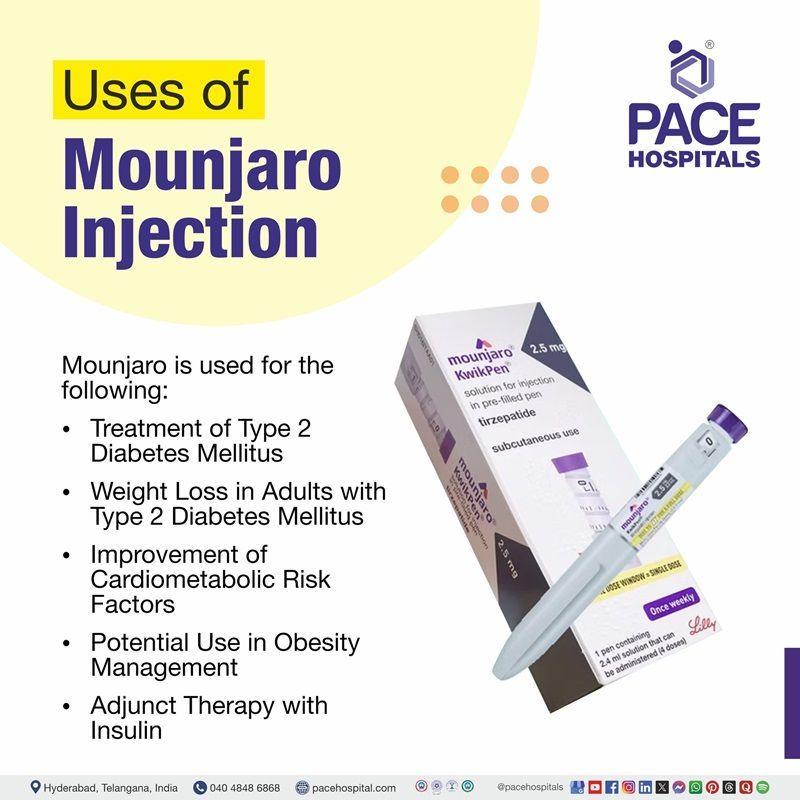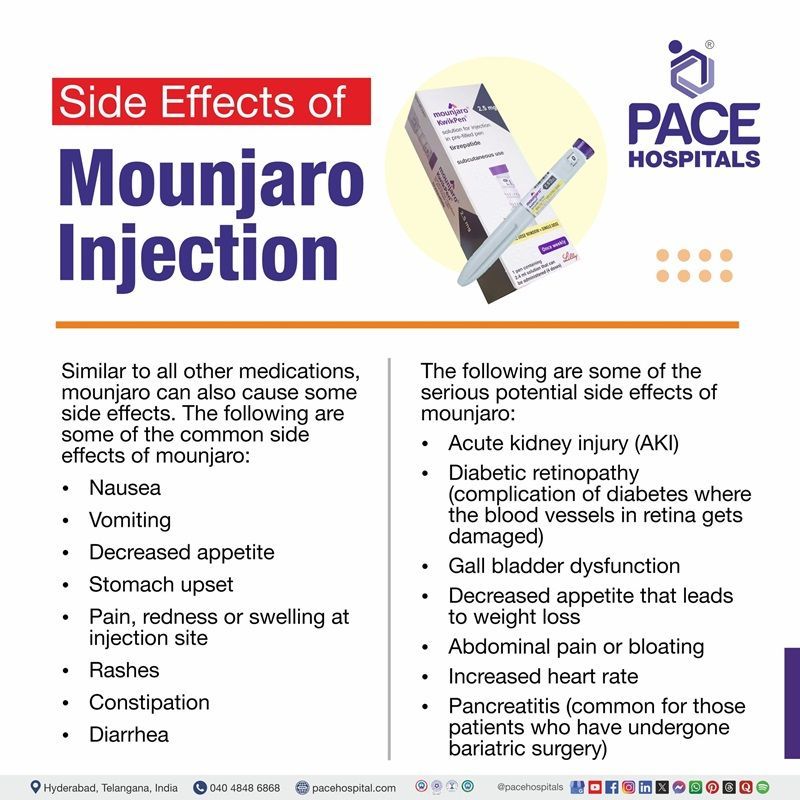Mounjaro Injection - Uses, Side Effects, Dosage, Composition
Manufactured By: Eli Lilly and Company, a U.S.-based pharmaceutical company.
Class: Dual Glucose-dependent Insulinotropic Polypeptide (GIP) receptor and the Glucagon-like Peptide-1 (GLP-1) receptor agonists
Overview
Mounjaro (Tirzepatide) Injection is a novel medication which is approved by the United States Food and Drug Administration (FDA) in May 2022. It is used for treating type 2 diabetes mellitus, and it also shows its efficacy in weight loss. It is a dual agonist for glucagon like peptide 1 and glucose dependent insulinotropic polypeptide receptors. It improves glycemic control and weight reduction in type 2 diabetes mellitus patients, maximizing benefits similar to glucagon like peptide 1 (GLP – 1) medications.
Mounjaro (Tirzepatide) is currently used as a second-line diabetes medication similar to glucagon like peptides 1 (GLP-1) drugs and is administered once weekly via subcutaneous injection with incremental dosage adjustments. It is not indicated for type 1 diabetes mellitus (T1DM) treatment and has not undergone studies in patients with pancreatitis.
Get Mounjaro (tirzepatide) Injection in Hyderabad, India
Mounjaro injection uses
1. Treatment of Type 2 Diabetes Mellitus
Mounjaro (tirzepatide) Injection is indicated for once-weekly administration as an adjunct to diet and exercise to improve glycemic control in adults with type 2 diabetes mellitus.
It can be used:
- As monotherapy when metformin is inappropriate due to contraindication or intolerance.
- In combination with other diabetic medications such as:
- Metformin
- Metformin and sulphonylureas
- Metformin and a sodium-glucose cotransporter 2 (SGLT2) inhibitor
- Basal insulin with or without metformin
2. Weight Loss in Adults with Type 2 Diabetes Mellitus
Clinical trials have shown Mounjaro (tirzepatide) Injection is superior to placebo in improving hemoglobin A1c (HbA1c) levels.
SURPASS-5 clinical trial findings:
- 5 mg/week: HbA1c reduction of -2.11% vs -0.86% with placebo
- 15 mg/week: HbA1c reduction of -2.34%
- Weight loss - 5 mg: 5.4 kg, 15 mg: 10.5 kg
Mounjaro demonstrated greater clinical improvements in glycemic control and weight loss compared to GLP-1 receptor agonists, insulin degludec, and insulin glargine.
Recognized by the American Diabetes Association (ADA) as a highly effective therapy for achieving glycemic control and weight loss.
3. Improvement of Cardiometabolic Risk Factors
Mounjaro has been shown to reduce:
- Blood pressure
- Visceral adiposity
- Circulating triglycerides
These factors are associated with reduced cardiovascular risk.
4. Potential Use in Obesity Management
- Mounjaro (tirzepatide) Injection is effective in promoting weight loss.
- Approved for obesity treatment in the United States and several European countries.
5. Adjunct Therapy with Insulin
- SURPASS-6 study: Mounjaro used with basal (slow-acting) insulin is safe and effective.
- Enhances blood sugar control, reduces A1c levels, and promotes weight loss compared to fast-acting insulin alone.
Mounjaro off label uses
Mounjaro (tirzepatide) Injection demonstrates its efficacy in weight loss, leading to its off-label use for treatment of obesity. It is not approved for type 1 diabetes mellitus (T1DM) treatment and has not undergone studies in patients with pancreatitis.

Guidelines to follow while taking Mounjaro (tirzepatide) Injection
- It is administered subcutaneously once a week, and the injection has to be administered the same day every week.
- It can be given at any time of the day and the ideal sites for injection include the abdomen, thigh or upper arm. Do not mix mounjaro injection with other injectable medications or products.
- The delay in gastric emptying may alter the absorption of other drugs.
- While administering mounjaro injections it is important to carefully monitor GLP 1 over exposure as it may cause pancreatitis particularly following bariatric surgery.
- It is important to stay hydrated to protect the kidney when the patient is battling nausea and vomiting.
Mounjaro mechanism of action
Mounjaro (tirzepatide) Injection is a synthetic polypeptide dual agonist for glucagon like peptides (GLP-1) and glucose-dependent insulinotropic polypeptide (GIP). This drug contains about 39 types of amino acids and is an analog of the gastric inhibitory polypeptide.
Functionally, it stimulates release of insulin from the pancreas and reduces hyperglycemia. It can also increase the levels of adiponectin. The dual agonism property of mounjaro can decrease hyperglycemia significantly more than glucagon like peptides (GLP-1) agonist agents and reduces the patient's appetite.
Mounjaro side effects
Similar to all other medications, Mounjaro (tirzepatide) Injection can also cause some side effects. But when side effects are mentioned as common in the patient information leaflet, it doesn’t mean that everyone who takes the medication will experience these side effects. The following are some of the common side effects of Mounjaro (tirzepatide) Injection:
- Nausea
- Vomiting
- Decreased appetite
- Stomach upset
- Pain, redness or swelling at injection site
- Rashes
- Constipation
- Diarrhea
The following are some of the serious potential side effects of Mounjaro (tirzepatide) Injection:
- Acute kidney injury (AKI)
- Diabetic retinopathy (complication of diabetes where the blood vessels in retina gets damaged)
- Gall bladder dysfunction
- Decreased appetite that leads to weight loss
- Abdominal pain or bloating
- Increased heart rate
- Pancreatitis (common for those patients who have undergone bariatric surgery )
NOTE: If a patient experiences any of the above-mentioned symptoms, the patient is recommended to consult a physician without delay.

Mounjaro Dose and Safety Guidelines
Mounjaro is administered via the subcutaneous route (injection given in the fatty tissue just under the skin). It is not yet available in oral form.
Mounjaro (tirzepatide) Injection is available in the following strengths:
- 2.5 mg per 0.5 mL
- 5 mg per 0.5 mL
- 7.5 mg per 0.5 mL
- 10 mg per 0.5 mL
- 12.5 mg per 0.5 mL
- 15 mg per 0.5 mL
The physician or endocrinologist typically initiates treatment with a low dose, which is gradually increased based on patient response and tolerability. Dose adjustments are not made more frequently than once every 4 weeks.
Mounjaro Dosage for Adults
In adults standard dosing is once weekly, the dose can be increased on follow-up visits on the basis of efficacy, as defined by HbA1c levels, body weight, and adverse effects.
The initial dosage of Mounjaro (tirzepatide) Injection for treatment initiation is 2.5 mg, which is administered subcutaneously once weekly, with the primary goal of initiation rather than glycemic control. After 4 weeks, the dose is gradually increased to 5 mg subcutaneously once weekly.
For additional glycemic control, increase the dosage by 2.5 mg after at least 4 weeks on the current dose. The maximum dosage is 15 mg administered subcutaneously once weekly.
When the dose is missed, it has to be administered within 4 days (96 hours) if viable; otherwise, the missed dose is skipped and return to the regular once-weekly schedule.
Mounjaro Dosage for Pediatrics
This drug has not yet been established as safe and effective for pediatric patients.
Mounjaro Dosage for Older patients
In a collective analysis of 7 clinical trials, 30.1 percent of patients were aged 65 or older, with 4.1 percent aged 75 or older. The safety and efficacy of the drug were comparable to younger patients, but older adults may experience heightened sensitivity to drugs due to age-related changes in their bodies.
Mounjaro Dosage for Specific Patient Population
- Hepatic Impairment: According to the product information from manufacturer, there is no suggested dosage adjustments for Mounjaro (tirzepatide) Injection in patients with hepatic impairment. But there is limited clinical experience in patients with mild, moderate, or severe hepatic impairment; therefore, Mounjaro (tirzepatide) Injection has to be used with caution in these patient populations.
- Renal impairment: There is no suggested dosage adjustment in patients with renal impairment. However, Mounjaro (tirzepatide) Injection is associated with gastrointestinal adverse drug reactions, that includes nausea, vomiting, and diarrhea, leading to dehydration that may lead to acute kidney injury. There is limited clinical experience in patients with mild, moderate, or severe hepatic impairment and therefore, it is advised to use Mounjaro (tirzepatide) Injection with caution in these patient populations.
Effects of Mounjaro in pregnancy and breastfeeding
Mounjaro in pregnancy
No clinical trials have been conducted for Mounjaro (tirzepatide) Injection in pregnant women. Clinical trial and studies in animals (namely rats and rabbits) have shown reproductive and developmental toxicity, including harm to fetal development and maternal weight loss. Mounjaro is contraindicated in pregnancy and when a patient plans for a pregnancy, Mounjaro has to be discontinued at least 1 month prior to a planned pregnancy because of its long half-life.
Mounjaro during breastfeeding
There is no information on the presence of Mounjaro (tirzepatide) Injection in animal or human milk or its effects on the breastfed infant. It is contraindicated for the duration of breast-feeding. Physicians have to consider the developmental and health benefits of breastfeeding, the mother's need for the drug, and the potential adverse effects on the breastfed infant. Therefore, until there are more clinical data available, Mounjaro has to be used cautiously during breastfeeding, especially in newborn or pre-term infants.
Overdosage of Mounjaro (tirzepatide) Injection
From an overdose with Mounjaro (tirzepatide) Injection, the potential symptoms could be gastrointestinal related, for example nausea. According to the patient’s clinical signs and symptoms, appropriate supportive care (including frequent blood glucose monitoring) can be initiated in case of Mounjaro (tirzepatide) Injection overdose. A prolonged period of observation and treatment for these symptoms may be required, considering the long half-life of Mounjaro.
Contraindications of Mounjaro (tirzepatide) Injection
Mounjaro (tirzepatide) Injection is contraindicated in the following conditions:
- It is contraindicated in patients who are hypersensitive to Mounjaro (tirzepatide) Injection or to any ingredient present in the formulation, including any nonmedicinal ingredient (including benzyl alcohol when using Mounjaro Kwik Pen), or any component of the container.
- It is contraindicated in patients having a personal or family history of medullary thyroid carcinoma (MTC) or Multiple Endocrine Neoplasia syndrome type 2 (MEN 2).
- It is also contraindicated in pregnant during or breast-feeding women.
Warnings and precautions of
Mounjaro (tirzepatide) Injection
- General: 5.4 mg benzyl alcohol is present in each 0.6 mL dose of mounjaro Kwik pen. Benzyl alcohol can cause allergic reactions. Therefore, hepatic or renal impairment patients have to be informed about the potential risk of metabolic acidosis because of accumulation of benzyl alcohol over time.
- Carcinogenesis & Mutagenesis: Mounjaro (tirzepatide) Injection can cause dose-dependent and treatment-duration-dependent thyroid C-cell tumors (adenomas and carcinomas) at clinically relevant exposures in male and female rats. It is not known whether this drug in humans can cause thyroid C-cell tumors, including medullary thyroid carcinoma (MTC). It is not known whether monitoring serum calcitonin or thyroid ultrasound can mitigate the human risk of thyroid C-cell tumors. Therefore, patients need to be counseled regarding the risk and symptoms of thyroid tumors.
- Cardiovascular: As mounjaro can increase heart rate, caution has to be taken in patients with cardiac conditions which might be worsened with use of mounjaro. There is no therapeutic experience in patients with congestive heart failure.
- Endocrine and metabolism: There might be an increased risk of hypoglycemia in patients using mounjaro in combination with an insulin secretagogue (e.g., a sulfonylurea) or insulin. This risk of hypoglycemia can be lowered by a reducing the dose of the insulin secretagogue or insulin. Do not use mounjaro in combination with other incretin drugs (e.g., GLP-1 receptor agonists or DPP-4 inhibitors) because the use of mounjaro in combination with these drugs has not been studied.
- Gastrointestinal: Mounjaro (tirzepatide) Injection has to be cautiously used in patients with severe gastrointestinal disease, including severe gastroparesis because the use of Mounjaro (tirzepatide) Injection in these patients has not been studied. Patients receiving Mounjaro (tirzepatide) Injection have reported malnutrition including severe, serious and fatal events. Therefore, proper nutritional guidance and supplementation have to be provided for patients. In severe or persistent cases of malnutrition, mounjaro discontinuation is considered.
- Hepatic/Biliary: In clinical trials and post-marketing of glucagon like peptide (GLP-1) receptor agonist acute events of gallbladder disease such as cholelithiasis or cholecystitis have been reported. In placebo-controlled trials of Mounjaro (tirzepatide) Injection, acute gallbladder disease (acute cholecystitis, biliary colic, and cholecystectomy) were reported by 0.6 percent of mounjaro treated patients and 0 percent of placebo-treated patients.
- Immune: In patients treated with Mounjaro (tirzepatide) Injection post marketing, cases of serious hypersensitivity reactions (e.g. anaphylactic reactions and angioedema) were reported. Discontinue the use of drug when hypersensitivity reactions occur and treat promptly, monitor until signs and symptoms resolve. Do not use in patients with a previous hypersensitivity to tripeptide or any of the excipients present in the composition.
- Monitoring and Laboratory Tests: Self-monitoring of blood glucose is necessary in order to reduce the risk of hypoglycemia when initiating treatment of Mounjaro (tirzepatide) Injection in combination with a sulfonyl urea or insulin, to reduce the dose of the sulfonyl urea or insulin.
- Ophthalmologic: Mounjaro (tirzepatide) Injection has to be cautiously used in patients with non-proliferative diabetic retinopathy, proliferative diabetic retinopathy, or diabetic macular edema because the use of Mounjaro in these patients have not been studied.
- Pancreatic: In patients treated with glucagon like peptide (GLP-1) receptor agonists, acute pancreatitis has been reported. Mounjaro (tirzepatide) Injection has to be discontinued, and appropriate management has to be initiated when pancreatitis is suspected and when confirmed, the drug cannot be restarted. In patients with a prior history of pancreatitis, Mounjaro (tirzepatide) Injection has to be used cautiously as in these patients, Mounjaro has not been evaluated.
- Psychiatric: Careful monitoring is required in patients treated with Mounjaro for the emergence or worsening of depression, suicidal thoughts or behaviors, and/or any unusual changes in mood or behavior.
- Renal: With use of Mounjaro (tirzepatide) Injection, gastrointestinal adverse reactions that include nausea, vomiting, and diarrhea have been reported, and these events may cause dehydration, which could result in renal function including acute renal failure. When initiating or escalating the Mounjaro in patients reporting severe adverse gastrointestinal reactions, carefully monitor renal function.
- Reproductive Health: During Mounjaro treatment the women of childbearing potential are recommended to use contraception as Mounjaro is contraindicated during pregnancy.
Mounjaro interactions
Drug interactions
Mounjaro (tirzepatide) Injection is known to interact with certain medications, which can affect its efficacy or can increase the risk of side effects. The following are some of the key drug interactions:
- Glucagon like peptide 1 agent: Mounjaro (tirzepatide) Injection is advised not to be administered to individuals using glucagon like peptide 1 agent such as semaglutide or liraglutide.
- Insulin: Patients on insulin therapy can be initiated on Mounjaro (tirzepatide) Injection therapy, but the insulin dose has to be cautiously decreased to minimize the risk of hypoglycemia.
- Oral contraceptives: Individuals on oral contraceptives are advised to use non-oral contraceptive methods, or they are advised to add a barrier contraceptive for 4 weeks after initiation and each dose escalation with mounjaro. With Mounjaro (tirzepatide) Injection the efficacy of oral hormonal contraceptives is decreased.
- Oral medications: Mounjaro delays gastric emptying, thereby impacting the absorption of concurrently administered oral medications. Therefore, caution is advised when using mounjaro with oral medications based on threshold concentrations or with a narrow therapeutic index (TI).
Food Interactions
According to product monograph, interaction with food have not been studied.
Mounjaro storage
Storage for Mounjaro single dose prefilled pen and vial
- Mounjaro (tirzepatide) Injection has to be stored in refrigerator at 2 degrees Celsius to 8 degrees Celsius, up to the expiration date. Do not use it beyond the expiration date. Do not freeze the vial. In order to protect it from sunlight, store it in the product carton. When needed, each single-dose pen or vial can be stored unrefrigerated for up to 21 days at temperatures not exceeding 30°C. Single dose prefilled pen after use has to be discarded in a puncture-resistant container while all the opened vials after usage, even if there is any drug left in the vial has to be thrown away.
Storage for Mounjaro Kwik pen multidose prefilled pen
- Mounjaro (tirzepatide) Injection has to be stored in the refrigerator at 2 degrees Celsius to 8 degrees Celsius, up to the expiration date. Keep away from sunlight, do not freeze it and if needed each multi-dose prefilled Kwik Pen can be stored unrefrigerated at temperatures not exceeding 30°C for up to 30 days. It has to be discarded in a puncture-resistant container or according to local requirements after four weekly doses.
Mounjaro injection composition
The active ingredient of Mounjaro is Tirzepatide. It also includes inactive ingredients such as sodium phosphate dibasic heptahydrated, sodium chloride, benzyl alcohol, glycerol, phenol, sodium hydroxide solution, concentrated hydrochloric acid, and water for injection.
Frequently Asked Questions (FAQs) on Mounjaro (Tirzepatide) Injection
What is Mounjaro Injection?
It is a novel medication which was approved by the United States Food and Drug Administration (FDA) for the treatment of type 2 diabetes mellitus (T2DM). It can significantly improve glycemic control and weight reduction in type 2 diabetes patients, maximizing benefits similar to glucagon like medications such as semaglutide.
What class of drug is Mounjaro Injection?
It is a dual agonist for the glucagon-like peptide-1 (GLP-1) and glucose-dependent insulinotropic polypeptide (GIP) receptors. It is the first medication in this drug class, that works by mimicking the effects of incretin hormones to manage blood sugar levels in type 2 diabetes patients.
Is mounjaro a hormone?
Mounjaro is not a hormone itself rather it is a drug which mimics two hormones involved in digestion, which are glucagon-like peptide-1 (GLP-1) and glucose-dependent insulinotropic polypeptide (GIP).
How does mounjaro work for weight loss?
Mounjaro contains an active ingredient called tirzepatide which works by activating both glucose-dependent insulinotropic polypeptide (GIP) and glucagon-like peptide-1 (GLP-1) receptors in the body. The dual agonism ability of the dug decreases hyperglycemia significantly more than glucagon like peptides (GLP-1) agonist agents and reduces the patient's appetite. This leads to decreased food intake and eventually weight loss.
What are the benefits of Mounjaro Injection?
Mounjaro has several benefits including managing type 2 diabetes mellitus and aiding in weight loss. The SURPASS-5 clinical trial showed a -2.11 percent reduction in HbA1c levels at 5 mg per week dosing and at the highest dose of 15 mg per week, mounjaro led to a -2.34 percent reduction in HbA1c. With 5 mg of mounjaro dosing, a weight reduction of 5.4 kg was observed.
What are the dosage adjustments of mounjaro in geriatrics?
There is no dose adjustment required in patients over the age of 65 years. The safety and efficacy of the drug were comparable to younger patients, but older adults may experience heightened sensitivity to drugs due to age-related changes in their bodies.
Does mounjaro need to be refrigerated?
Yes, it is important to store Mounjaro (tirzepatide) Injection in refrigerator at 2 degrees Celsius to 8 degrees Celsius up to the expiration date. But it has to be noted that the drug must not be freezing.
Is mounjaro safe to use?
Mounjaro (tirzepatide) Injection is approved by the Food and Drug Administration for long-term use for treating type 2 diabetes patients, which means that it has shown to be safe for long-term use. It has undergone several clinical trials and achieved approval in diabetes treatment.
How is mounjaro administered?
The drug is administered subcutaneously (injected into the fatty layer of tissue under the skin) once a week and it has to be administered the same day every week. It can be given at any time of the day and the site for injecting the drug includes the abdomen, thigh and upper arm.
What are the side effects of Mounjaro (tirzepatide) Injection?
Nausea, vomiting, constipation and diarrhea are the common side effects of mounjaro. Other potential side effects include acute kidney injury (AKI), gall bladder dysfunction, decreased appetite that leads to weight loss, abdominal pain or bloating and pancreatitis.
Who should not use Mounjaro (tirzepatide) Injection?
Individuals with a personal or family history of medullary thyroid cancer or MEN 2 syndrome, those allergic to the mounjaro ingredients, people with a history of pancreatitis, severe gastrointestinal diseases, or significant kidney problems are advised not to use mounjaro. This drug is also not recommended for pregnant or breastfeeding women.
What to do If missed a mounjaro dose?
When a dose of Mounjaro (tirzepatide) Injection is missed, it has to be administered within 4 days (96 hours) if viable; otherwise, the missed dose is skipped and return to the regular once-weekly schedule.
Is it safe to use mounjaro in pregnancy?
Mounjaro (tirzepatide) Injection is not considered safe in pregnancy and when a patient plans for a pregnancy, Mounjaro Injection has to be discontinued at least 1 month prior to a planned pregnancy. Clinical trial and studies in animals (namely rats and rabbits) have shown reproductive and developmental toxicity, including harm to fetal development and maternal weight loss. Because of this reason, the use of Mounjaro (tirzepatide) Injection is contraindicated in pregnancy.
Share on
Request an appointment
Fill in the appointment form or call us instantly to book a confirmed appointment with our super specialist at 04048486868











